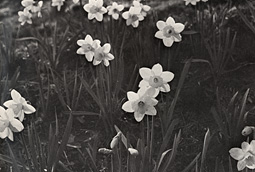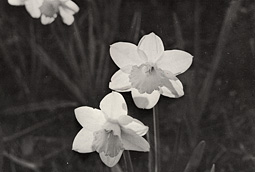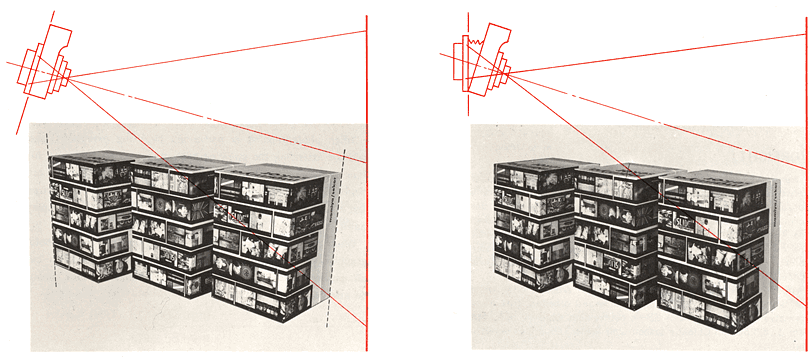
Back mount unextended

Back mount extended

Mamiya Press Super 23
Users Guide

The Mamiya Press Super 23 can be effectively used in close-up photography by extending the back mount up to a maximum of 13/16 in. (30 mm). By swinging the back mount, both depth of field control and slight perspective control is achievable. The back mount swings and tilts up to 15° in each direction.
Loosen the four back mount swing lock knobs (#3) by turning them in the direction opposite to the arrow marks. When the back mount (#29) is extended to the required position, fasten it by turning the four lock knobs in the direction of the arrow marks.
Keeping the shutter open, decide composition of the picture on the ground glass and adjust the focus. When the back mount is extended, or when the lens-shutter assembly of the 100 mm f/3.5 lens is in its retracted position, the coupled rangefinder will not function, also the depth of field scale (#17) cannot be used.
| Lens | Lens to subject distance | Magnification | Subject coverage | Exposure factor |
| 50 mm f/6.3 | 313/16" (97 mm) | 0.69 |
37/32×427/32" (81.7×123 mm) 37/32×41/8" (81.7×105 mm) | 2.8 |
| 65 mm f/6.3 | 61/8" (156 mm) | 0.57 |
315/16×513/16" (100×148 mm) 315/16×43/4" (100×120 mm) | 2.5 |
| 100 mm f/3.5 | 1' 1/8" (308 mm) | 0.45 |
415/16×73/8" (126×188 mm) 415/16×6" (126×152 mm) | 2.1 |
| 150 mm f/5.6 | 2' 5/8" (625 mm) | 0.3 |
73/8×1015/16" (187×278 mm) 73/8×87/8" (187×225 mm) | 1.7 |
| 250 mm f/5 | 5' 3/8"(1534 mm) | 0.21 |
103/4×1' 313/16" (274×402 mm) 103/4×1' 1" (274×329 mm) | 1.5 |
The values in the table represent those when the lens distance scale is set at the closest distance, and the back mount is fully extended.
Lens to subject distances represent those from the front extremity of the barrel to the subject.
Subject coverage is the area of the subject registered on the focusing screen (21/4×35/16 in. 57×84 mm). The values in the upper lines of the column indicate 6×9 cm format; the lower lines designate 6×7 cm format.
When the back mount is extended for close-up photographing, it is necessary to adjust for the increased exposure factor. Measure the brightness of the subject with an exposure meter, then compensate the exposure value with the exposure factor.
 Back mount unextended |
 Back mount extended |
Conventional cameras are designed to accomplish focusing on a film plane which meets the optical axis of the lens at right angles; depth of field control is achieved only by aperture setting.
The Mamiya Press Super 23 controls depth of field not only by aperture setting, but also by permitting swinging or tilting of its back mount, which can render an exaggerated effect on perspectives and offers an enormous depth of field. The back mount swing can be employed for commercial photography, architectural photography, and many other useful purposes.
Adjust the focus and the depth of field by moving both the back mount (#29) and the focusing ring (#15), observing the subject on the focusing screen; then fasten the back mount by turning the lock knobs on all four corners.
When using the 100 mm f/3.5 lens, and the lens is not in a retracted position, if the back mount swing angle is large, additional depth of field photography is adaptable only for close-range. However, if the lens is retracted, a plane of wide distance range from infinity to close range will be in focus.
When using a lens without a retracting device, if the swing angle is large, this method is fit for close-range swing photography.
Generally, in a condition that one side of the swinging back mount comes near the camera body, and in proportion to a smaller swing angle, the focus gradually shifts to a long distance. Further, when the entire swinging back mount is separated from the body and swung, or when extending the lens, the focus will move to close range in proportion to that particular swing or lens extension.

| a. Tilted back mount | d. Near limit of depth of field |
| b. Optical center | e. Plane of sharpest focus |
| c. Focusing screen | f. Far limit of depth of field |
Same Lens at Same Aperture
 Back mount untilted |
 Back mount tilted |

In close-up photography, one area of the subject can be highlighted or emphasized, throwing the other areas out of focus by using the back mount swing.
Swing or tilt the back mount in the opposite direction utilized to obtain additional depth of field.

Mamiya Press Super 23 can correct the converging lines of perspectives (controls the contour of the image on the film) to some degree.
While observing the subject on the focusing screen, swing or tilt the back mount in parallel with the subject being photographed, adjust the perspective, focus on the most important part of the subject and turn the aperture control lever until the aperture covers the subject in the depth of field.
By retracting the lens-shutter assembly of the 100 mm f/3.5 lens, a slight perspective rendition can be achieved on the subject even at further than medium distance. In this case, depth of field can be controlled only by the aperture setting.
Perspective rendition can be achieved with a wide angle lens on a subject only at close range. Using other long focal length lenses which do not retract, perspective rendition cannot be achieved on the subject further than medium distance.